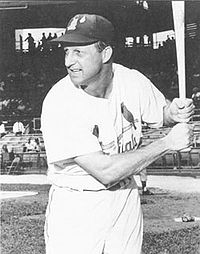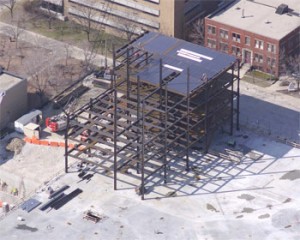Milwaukee Cardinals Baseball Team v. Major League Baseball (1953): The Antitrust Case That Might Have Changed the Face of the National Pastime
 Few baseball fans today know how close the St. Louis Cardinals came to moving to Milwaukee in January of 1953. Had such a move occurred, and had Major League Baseball attempted to block it, organized baseball’s vaunted antitrust exemption might have ended decades ago.
Few baseball fans today know how close the St. Louis Cardinals came to moving to Milwaukee in January of 1953. Had such a move occurred, and had Major League Baseball attempted to block it, organized baseball’s vaunted antitrust exemption might have ended decades ago.
That a major league team might be relocated in time for the 1953 season was a frequent topic of Hot Stove League conversation following the conclusion of the 1952 season. Although no major league team had switched its base city since 1903, the Congressional hearings on baseball conducted by the Celler Committee in 1951 and 1952 had revealed considerable dissatisfaction with the current major league line-up which featured 16 teams in ten cities, none of which were west of St. Louis. There were three teams in New York, two each in Boston, Chicago, Philadelphia, and St. Louis, with single teams in Cincinnati, Cleveland, Detroit, Pittsburgh, and Washington. With little support among current owners for increasing the number of major league teams, the logical alternative was to move some of the teams from the multiple-team cities to cities that currently had only minor league baseball.
Much of the speculation focused on St. Louis.
While St. Louis had been the fourth-largest city in the United States in 1902 when the American League’s Milwaukee Brewers moved there to compete with the National League’s Cardinals under the new name of the Browns, St. Louis’ growth had not kept pace with that of other cities in the first half of the twentieth century. Many observers questioned the wisdom of continuing to have two teams in the Gateway city. On September 23, 1952, the New York Times reported that the St. Louis Cardinals might be Milwaukee bound because of disagreements regarding their lease of Sportsman Park which was owned by their American League counterparts, the Browns. (Milwaukee’s new Milwaukee County Stadium made the city a particularly attractive destination for a baseball team needing a new home.) A December 23, 1952, story in the Washington Post predicted that it would be the St. Louis Browns, not the Cardinals, that would be moving to Milwaukee within the next two or three years. (The Browns were then owned by Bill Veeck, the former owner of Milwaukee’s minor league team, the Brewers.)
The situation came to a head dramatically on January 28, 1952, when Cardinal owner Fred Saigh pled “no contest” to charges of income tax evasion in federal court in St. Louis and was sentenced to 15 months in prison. Fearing that his fellow owners would strip him of his franchise, Saigh immediately agreed to give up control of the Cardinals and to sell his 90% ownership stake in the team. At that point several Milwaukeeans, anxious to have major league baseball return to their city, undertook to bring the Cardinals to Wisconsin.
A January 30, 1953, New York Times article identified Fredrick C. Miller of the Miller Brewing Company, as one of several individuals reportedly interested in purchasing the Cardinals. Actually, by that date, Saigh had already offered to sell the Cardinals to Miller for $4.5 million dollars, but Miller had balked at the price. The Milwaukee Journal reported that same day that Miller had declined Saigh’s initial offer, but the paper was optimistic that a deal could still be worked out. Almost immediately after Miller declined Saigh’s initial offer, a “Milwaukee syndicate” (which may have included Miller) made a “feeler offer” for the team that Saigh rejected. Potential buyers from Houston and St. Louis were also bidding for the team, and on January 31, the Associated Press reported that several “undisclosed groups” had made offers to purchase the club but that Saigh intended to sell to St Louis interests.
In spite of the reports that he intended to keep the team in St. Louis, Saigh continued to negotiate with the Milwaukee group which offered $4.1 million dollars for the Cardinals during the first week of February. On February 14, Saigh was apparently close enough to accepting the Milwaukee offer that Cardinal front office employees were told that if they wished to move with the club to Milwaukee their moving expenses would be paid by the team. However, his reluctance to sell the team to owners who would move the club away from St. Louis led Saigh to put the Milwaukee offer on hold while he continued to search for a local buyer.
No one has convincingly explained Saigh’s refusal to sell the team to the Milwaukee buyers. On February 21, the United Press reported that a week earlier Saigh had been close to agreeing to transfer the Cardinals to the Milwaukee ownership group. According to the UP Saigh had advised the Anhauser Busch representatives that he was about to close a deal with the Milwaukee group, and if the St. Louis-based brewery wanted the team it would have to act immediately. And it did, offering Saigh $3.75 million for the team, a figure less than the Milwaukee offer, but apparently large enough to satisfy Saigh. The same day, the Wisconsin State Journal, a Madison daily, quoted Saigh as saying that once he had an outside bidder willing to pay a fair price for the club, he offered it to Anheuser-Busch at the same price. The outside bidder was not identified but the way the story is positioned on the paper’s sports page, it seems clear that most readers would know that the buyer was from Wisconsin.
Saigh may well have been using outside bidders from Milwaukee (and possibly other cities) to establish a market price for the team and to convince local bidders that even though he was being forced to sell the team, he was not going to sell it for a fire-sale price. By mid-February he clearly intended to sell the Cardinals to a St. Louis buyer if one could be found who was willing to pay close to the team’s actual value. And when he found such a bidder in Auggie Busch, he sold him the team. This was Saigh’s own explanation and one accepted by most sports journalists at the time.
However, it is also possible that Saigh, desperate to extricate himself from an embarrassing situation, was worried that his fellow owners might veto the sale of the popular Cardinals to individuals who planned to move the team. Although the Cardinals had attendance issues in St. Louis, they were one of the most widely-followed teams in the United States and had an extraordinarily large fan base in the South and in the states of the western plains.
If this had been the case, and had Saigh sold the team to the Milwaukee buyers anyway, then it seems likely that the owners would have failed to approve the sale. A second possible obstructionist scenario would have involved the minor league Milwaukee Brewers (owned by Lou Perini who also owned the major league Boston Braves). Under the terms of the National Agreement (the contract arrangement that bound together the major and minor leagues) the Brewers could have invoked their territorial rights to block the movement of another organized baseball team into their territory. If either of these scenarios had occurred the new Milwaukee owners would have had strong reasons to bring suit against organized baseball under the federal antitrust laws. Such an action almost surely would have been brought in federal court in Wisconsin, where a sympathetic judge and jury were likely to be found.
If such a suit had been filed in 1953, what would have been the result?
One might think that organized baseball would have been insulated from such a lawsuit because of its antitrust exemption. However, in January and February of 1953, the baseball antitrust exemption was anything but secure. The Toolson v. New York Yankees decision that would confirm the exemption would not be handed down until the following November, and many observers in 1953 expected the baseball antitrust exemption to go the way of the insurance and manufacturing antitrust exemptions and other pre-New Deal limitations on the scope of the Sherman Act.
Four years earlier, the prestigious United States Second Circuit Court of Appeals had ruled in the case of Gardella v. Chandler that Major League Baseball was no longer exempt from the federal antitrust laws, and baseball had decided not to challenge that ruling by bringing the matter before the Supreme Court. Moreover, when dealing with broadcasting issues involving Major League Baseball and the National Football League in the early 1950’s, the Justice Department had consistently taken the position that the Sherman Act clearly now applied to organized baseball, at least in regard to broadcasting issues.
On the other hand, in December 1952, the Ninth Circuit Court of Appeals had ruled that the antitrust exemption created by the 1922 Supreme Court decision in Federal Baseball was still valid. On February 20, 1953, just as Fred Saigh decided to reject the Milwaukee offer to purchase the Cardinals, the Sixth Circuit reached a similar decision upholding the continued validity of the exemption.
The confusion was resolved that November when the Supreme Court ruled 7-2 in Toolson v. New York Yankees that the baseball antitrust exemption survived, at least until Congress chose to repeal it. However, Toolson and its two companion cases involved issues related to the operation of minor league baseball, an institution somewhat irrationally valued by many Americans and whose continued existence could be threatened by the application of the antitrust laws to the web of restrictions on players and team owners that made it viable. None of the three touched on the issues of territorial exclusivity or the relocation of major league franchises. While the Milwaukee case would have arisen too late to be consolidated with Toolson, the existence of a franchise relocation case hovering in the background might have prompted several of the Supreme Court justices to view the issues in a different light.
Had the owners nixed the transfer and had the Milwaukee interests sued Major League Baseball under the Sherman Act, the entire history of baseball and antitrust might have turned out differently.
As it turned out, Milwaukee baseball fans quickly forgot about the Milwaukee Cardinals. On March 18, 1953, only a month after Fred Saigh turned down the Milwaukee offer, Lou Perini, the owner of the woeful Boston Braves, announced that the Braves were moving immediately to Milwaukee and would play there during the 1953 season. (Because Perini also owned the Milwaukee Brewers, there was no issue of territorial exclusivity. The minor league Brewers were quickly dispatched to professional baseball-less Toledo, which was happy to take the team.)
Almost as quickly as the disappointing saga of the Milwaukee Cardinals ended, the glorious saga of the Milwaukee Braves began. Playing in their new stadium, the Braves quickly shattered the all-time major league attendance record and within four years were playing the New York Yankees in the World Series. The Cardinals did not make it back to the World Series until 1964.
Although the major league owners readily approved the transfer of the Braves from Boston to Milwaukee, it is not necessarily the case that they would have approved the transfer of the Cardinals. In 1952, the American League owners rejected St. Louis Browns owner Bill Veeck’s various proposals to move the Browns to Milwaukee, Los Angeles, Miami, or Baltimore, but Veeck was especially disliked by his fellow owners, who may have opposed his proposals on purely personal grounds. Although the Cardinals were not drawing exceptionally large crowds in the early 1950’s, they were not an economic basket case like the Boston Braves or the Browns. (In 1952, the Cardinals averaged just under 12,000 fans per game, fourth best in the National League. The Braves, in contrast, averaged only 3600 fans and the Browns only 6600.)
It is also interesting to speculate what might have happened had the Cardinals, not the Braves, moved to Milwaukee in 1953. The Browns almost certainly would have stayed put in St. Louis. Lou Perini, the owner of the Braves, was exploring the option of moving to San Francisco (as well as Milwaukee) in 1953, and presumably would have moved to San Francisco, if not in 1953 then in some year thereafter. The New York Giants seriously contemplated relocating to Minneapolis in the mid-1950’s, and with San Francisco occupied by the Braves, they would have likely moved to the Twin Cities as their attendance in New York continued to plummet. Baseball could well have ended up with the Minneapolis Giants and the San Francisco Braves.
Given the well-documented recalcitrance of Robert Moses and Walter O’Malley, the Dodgers would have still moved to Los Angeles in 1957, but the Senators might have stayed in Washington, D. C., particularly if Minneapolis was already taken by the Giants. Rather than move to Kansas City, the Philadelphia Athletics might simply have relocated down the road to Baltimore, where they probably would have retained the Athletics name. By 1958, the baseball map would have been basically the same as it actually was, with a team in Minneapolis rather than Kansas City being the only difference, but there would have been some very different uniforms. Whether the Milwaukee Cardinals would have abandoned the Brew City in 1966 for Atlanta is a question the answer to which no one will ever know.


